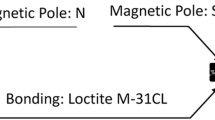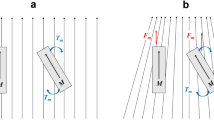Abstract
Introduction
Standard microguidewires used in interventional neuroradiology have a predefined shape of the tip that cannot be changed while the guidewire is in the vessel. We evaluated a novel magnetic navigation system (MNS) that generates a magnetic field to control the deflection of a microguidewire that can be used to reshape the guidewire tip in vivo without removing the wire from the body, thereby potentially facilitating navigation along tortuous paths or multiple acute curves.
Method
The MNS consists of two permanent magnets positioned on either side of the fluoroscopy table that create a constant precisely controlled magnetic field in the defined region of interest. This field enables omnidirectional rotation of a 0.014-inch magnetic microguidewire (MG). Speed of navigation, accuracy in a tortuous vessel anatomy and the potential for navigating into in vitro aneurysms were tested by four investigators with differing experience in neurointervention and compared to navigation with a standard, manually controlled microguidewire (SG).
Results
Navigation using MG was faster (P=0.0056) and more accurate (0.2 mistakes per trial vs. 2.6 mistakes per trial) only in less-experienced investigators. There were no statistically significant differences between the MG and the SG in the hands of experienced investigators. One aneurysm with an acute angulation from the carrier vessel could be navigated only with the MG while the SG failed, even after multiple reshaping manoeuvres.
Conclusion
Our findings suggest that magnetic navigation seems to be easier, more accurate and faster in the hands of less-experienced investigators. We consider that the features of the MNS may improve the efficacy and safety of challenging neurointerventional procedures.





Similar content being viewed by others
References
Faddis MN, Lindsay B (2003) Magnetic catheter manipulation. Coron Artery Dis 14:25–27
Faddis MN, Blume W, Finney J, et al (2002) Novel, magnetically guided catheter for endocardial mapping and radiofrequency catheter ablation. Circulation 106:2980–2985
Ernst S, Ouyang F, Linder C, et al (2004) Initial experience with remote catheter ablation using a novel magnetic navigation system: magnetic remote catheter ablation. Circulation 109:1472–1475
Tillander H (1951) Magnetic guidance of a catheter with articulated steel tip. Acta Radiol 35:62–64
Tillander H (1956) Selective angiography of the abdominal aorta with a guided catheter. Acta Radiol 45:21–26
Ram W, Meyer H (1991) Heart catheterization in a neonate by interacting magnetic fields: a new and simple method of catheter guidance. Cathet Cardiovasc Diagn 22:317–319
Jenkins A, Parker H (1959) Electromagnetic support arrangement with three dimensional control. J Appl Phys 30:238–239
Yodh SB, Pierce NT, Weggel RJ, Montgomery DB (1968) A new magnet system for “intravascular navigation”. Med Biol Eng 6:143–147
Schiemann M, Killmann R, Kleen M, Abolmaali M, Finney J, Vogl TJ (2004) Vascular guide wire navigation with a magnetic guidance system: experimental results in a phantom. Radiology 232:475–481
Dietrich T, Kleen M, Killmann R, et al (2004) Evaluation of magnetic navigation in an in vitro model of uterine artery embolization. J Vasc Interv Radiol 15:1457–1462
Grady MS, Howard MA, Dacey RG, et al (2000) Experimental study of the magnetic stereotaxis system for catheter manipulation. J Neurosurg 93:282–288
Ernst S, Hachiya H, Chun JK, Ouyang F (2005) Remote catheter ablation of parahisian accessory pathways using a novel magnetic navigation system – a report of two cases. J Cardiovasc Electrophysiol 16:659–662
Krings T, Moller-Hartmann W, Hans FJ, et al (2003) A refined method for creating saccular aneurysms in the rabbit. Neuroradiology 45:423–429
Soderman M, Babic D, Homan R, Andersson T (2005) 3D roadmap in neuroangiography: technique and clinical interest. Neuroradiology 47:735–740
Conflict of interest statement
We declare that we have no conflict of interest.
Author information
Authors and Affiliations
Corresponding author
Rights and permissions
About this article
Cite this article
Krings, T., Finney, J., Niggemann, P. et al. Magnetic versus manual guidewire manipulation in neuroradiology: in vitro results. Neuroradiology 48, 394–401 (2006). https://doi.org/10.1007/s00234-006-0082-3
Received:
Accepted:
Published:
Issue Date:
DOI: https://doi.org/10.1007/s00234-006-0082-3




